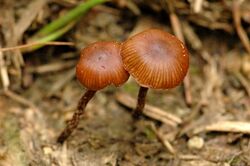Biology:Deconica
| Deconica | |
|---|---|

| |
| Deconica montana | |
| Scientific classification | |
| Domain: | Eukaryota |
| Kingdom: | Fungi |
| Division: | Basidiomycota |
| Class: | Agaricomycetes |
| Order: | Agaricales |
| Family: | Strophariaceae |
| Genus: | Deconica (W.G.Sm.) P.Karst. (1879) |
| Synonyms[1] | |
| |
Deconica is a genus of mushroom-forming fungi in the family Strophariaceae. It was formerly considered synonymous with Psilocybe until molecular studies showed that genus to be polyphyletic, made of two major clades: one containing bluing, hallucinogenic species, the other non-bluing and non-hallucinogenic species. Deconica contains species formerly classified in the sections Deconica and Coprophila of Psilocybe.[2]
Taxonomy
Until recently, Deconica was generally considered to be synonymous with Psilocybe, and was originally named as a subgenus of Agaricus by Worthington George Smith in 1870.[1] It was later raised to generic level by Petter Karsten in 1879.[3] However, several molecular studies published in the 2000s demonstrated that Psilocybe, as it was defined then, was polyphyletic.[4][5][6] The studies supported the idea of dividing the genus into two clades, one consisting of the bluing, hallucinogenic species, and the other made of the non-bluing, non-hallucinogenic species. However, the generally accepted lectotype (a specimen later selected when the original author of a taxon name did not designate a type) of the genus as a whole was Psilocybe montana, a non-hallucinogenic species; if those forms of the species in the study were to be segregated, it would leave the hallucinogenic clade without a valid name. To resolve this taxonomical dilemma, it was proposed in 2005 to conserve the name Psilocybe, with P. semilanceata as the type, leaving the option to use Deconica as the name for the non-hallucinogenic clade.[7] The proposal was accepted unanimously by the Nomenclature Committee for Fungi in 2009.[8] Recently, it has been reported that the non-bluing Psilocybe fuscofulva does not produce hallucinogenic compounds.[9] Thus, non-hallucinogenic species are also covered by the genus Psilocybe, not only Deconica.
Deconica had previously been recognized as a separate genus by several authors, including Rolf Singer in 1951,[10] Dennis and Orton in 1960,[11] and Horak in 1979.[12]
Species
Many species in Deconica were transferred there by mycologist Machiel Noordeloos in a 2009 publication.[13]
References
- ↑ 1.0 1.1 "Deconica (W.G. Sm.) P. Karst. 1879". MycoBank. International Mycological Association. http://www.mycobank.org/MycoTaxo.aspx?Link=T&Rec=17469.
- ↑ Noordeloos M.. "Deconica pages". www.entoloma.eu. http://www.entoloma.nl/html/psilocybeeng.html.
- ↑ "Rysslands, Finlands och den Skandinaviska halföns Hattsvampar. Förra Delen: Skifsvampar". Bidrag till Kännedom of Finlands Natur Folk 32 (26): 515.
- ↑ "One hundred and seventeen clades of euagarics". Molecular Phylogenetics and Evolution 23 (3): 357–400. 2002. doi:10.1016/S1055-7903(02)00027-1. PMID 12099793.
- ↑ "Forensic analysis of hallucinogenic fungi: a DNA-based approach". Forensic Science International 140 (2–3): 147–57. 2004. doi:10.1016/j.forsciint.2003.11.022. PMID 15036436.
- ↑ "Major clades of Agaricales: a multilocus phylogenetic overview". Mycologia 98 (6): 982–995. 2006. doi:10.3852/mycologia.98.6.982. PMID 17486974.
- ↑ "(1757) Proposal to conserve the name Psilocybe (Basidiomycota) with a conserved type". Taxon 56 (1): 255–257. 2005. http://www.bio.utk.edu/matheny/Site/Publications_files/Redhead_conserve_Psilocybe_Taxon.2007.pdf.
- ↑ Norvell L. (2009). "Report of the Nomenclature Committee for Fungi: 15". Mycotaxon 110: 487–92. doi:10.5248/110.487. http://www.ima-mycology.org/CFF/pdf/Fungi-15.pdf.
- ↑ "Phylogenetic and chemical studies in the potential psychotropic species complex of Psilocybe atrobrunnea with taxonomic and nomenclatural notes". Persoonia 34 (6): 1–9. 2015. doi:10.3767/003158515X685283. PMID 26240441.

- ↑ Lilloa 22: 504. 1951
- ↑ "New check list of British agarics and boleti. Parts I, II, III, and IV". Transactions of the British Mycological Society 43 (2): 159–439, 440–59. 1960. doi:10.1016/s0007-1536(60)80067-8. http://www.cybertruffle.org.uk/cyberliber/59351/0043/002/0159.htm.
- ↑ Flora Criptog. Tierra del Fuego 11(6): 243. 1979
- ↑ Noordeloos M. (2009). "The genus Deconica (W. G. SM.) P. KARST. in Europe – new combinations". Österreichische Zeitschrift für Pilzkunde 18: 207–210. http://www.entoloma.nl/pdf/Noordeloos_Deconica.pdf. Retrieved 2011-09-01.
- ↑ 14.0 14.1 14.2 14.3 14.4 14.5 14.6 Ramírez-Cruz, Virginia; Guzmán, Gastón; Guzmán-Dávalos, Laura (2012). "New combinations in the genus Deconica (Fungi, Basidiomycota, Agaricales)". Sydowia 64: 217–219.
- ↑ 15.0 15.1 15.2 15.3 15.4 da Silva PS. (2013). Os gêneros Deconica (W.G.Sm.) P.Karst.e Psilocybe (Fr.) P. Kumm. (Agaricales) na região Sul do Brasil : contribuíção á sua filogenia com bases morfológicas, moleculares e químicas (PDF) (Thesis). Universidade Federal do Rio Grande do Sul. Instituto de Biociências. Programa de Pós-Graduação em Botânica. Retrieved 29 November 2014.
- ↑ 16.0 16.1 16.2 "Type studies of Psilocybe sensu lato (Strophariaceae, Agaricales)". Sydowia 65: 277–319. 2013.
- ↑ "Psilocybe chuxiongensis, a new bluing species from subtropical China". Phytotaxa 156 (4): 211–20. 2014. doi:10.11646/phytotaxa.156.4.3.
- ↑ "Deconica neorhombispora (Agaricales, Strophariaceae): new combination and synonym". Sydowia 65: 321–328. 2013.
Wikidata ☰ Q5249581 entry
 |

